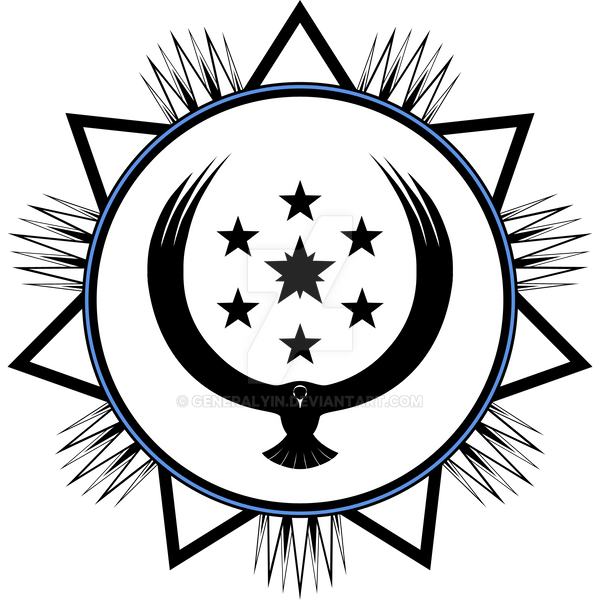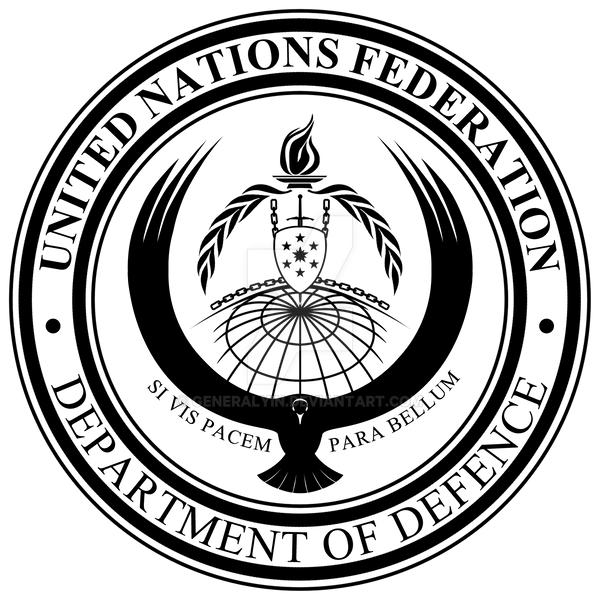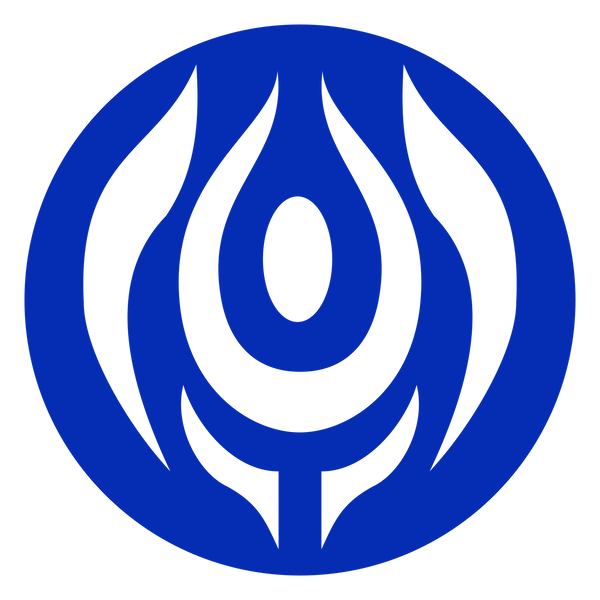HOME | DD
 GeneralYin — 3D High: UNF Defence Forces Roundel
by-nc-nd
GeneralYin — 3D High: UNF Defence Forces Roundel
by-nc-nd

Published: 2012-07-23 15:20:26 +0000 UTC; Views: 2440; Favourites: 27; Downloads: 0
Redirect to original
Description
Created for use as part of a work-in-progress anime/manga universe: 3D High.Takes place in a universe where mythical creatures are real and deadly threats to life and limb, and there are multiple dimensions populated by other sentient beings aside from humanity.
Our dimension has endured the devastating consequences of being suddenly connected to other dimensions, destabilization of the fabric of reality across the world, killing billions, and rendering large swaths of land unsafe for human habitation to this day.
--------------------------------
INSIGNIA
Standard insignia identifying military assets that are property of the Federation Defence Forces.
This is the traditional version that is most commonly found on the side of military vehicles, aircraft and ships that are taking part in a peacekeeping mission (the peacekeepers must be easily spotted and identified). It may also be found printed on supply containers, documents and military installations.
--------------------------------
SYMBOLISM
- The seven stars are carried over from the state flag, representing the 7 continents of the world.
- The swooping dove is a central feature on the state flag, standing for freedom and peace. Its glare represents the determination of mankind to secure freedom if peace is no longer possible.
- The seven pointed star represents the 7 areas of responsibility that the globe is divided into. Within each, regional commanders have the authority to conduct and plan military operations.
- The 49 smaller rays represent the first 49 divisions initially established under the Defence Force chain of command.
--------------------------------
ABOUT
Upon the founding of the Federation in 2030 CE, the United Nations Peacekeeper Corps was expanded and renamed the United Nations Federation Defence Forces (UNFDF), evolving into a multinational military force, independent of member state governance, under the administration of the Federation Department of Defence. The Defence Forces have jurisdiction in all member state territories to guard against any military threats to mankind.
Recruits are drawn directly from the civilian populations of all member states, and from national militaries. All recruits are volunteers, and are evaluated for the ability to put nationalism aside for the good of humanity as a whole. They are trained in tactics from militaries around the world and utilize humanity's most advanced weapons technology.
The Secretary-General, as commander-in-chief, can direct the Defence Forces into action upon convening the Emergency Executive Council if immediate action is necessary. However, the Secretary-General may be required resign his post following the authorization of the use of force (as written in Article III in the revised UN Constitution). This is to safeguard against the possibility that the Secretary-General will continue to abuse their position as commander-in-chief. The Secretary-General may retain his post if a super-majority of Global Parliament members vote to overturn the resignation penalty.
The Defence Forces primarily serve as a shield against constant rift-mutant incursions that have plagued humanity ever since the Rift Crisis of 2015 CE, with ground force garrisons protecting population centres in close proximity to Exclusion Zones, while conducting frequent patrols within the Exclusion Zones and outer Rift-zones themselves.
The air force branch of the Defence Forces devote most of their resources to patrolling air corridors in close proximity to Rift-zones, protecting commercial flights from attack by airborne rift-mutants.
The naval branch primarily combats piracy in more dangerous shipping lanes near lawless areas, while protecting cargo ships that pass through shipping routes that run close to maritime Rift-zones.
Member states retain the right to maintain national militaries, but they must submit to regional or federal authority if requested, and may be mobilized under the command of a Federation general officer to support Federation Defence Force operations.
--------------------------------
REGIONAL COMMANDERS
- Highest Ranking Military Officer: (m) UMSC Chief of Staff, Supreme Commander of the United Nations Defence Forces, 5-star General Prach KEO, Kingdom of Cambodia (Based in Taipei FMC, Republic of China)
- North American Command (NAM-COM): (f) 4-star Air Force General Addison W. BLAIR, Canada (Based in Montreal AFB, Canada)
- South American Command (SAM-COM): (m) 4-star Ground Force General Emilio VALDEZ, Republic of Ecuador (Based in Brasilia FMC, Brazil)
- Caribbean Command (CARI-COM): (m) Fleet Admiral Byron DAWES, Jamaica (Based in Havana NFB, Cuba)
- African Command (AFRI-COM): (m) 4-star Ground Force General Zuberi MTAMBI, Republic of Uganda (Based in Yamoussoukro LFB, West African Republic)
- European Command (EURO-COM): (m) 4-star Air Force General Konrad BJORNE, Kingdom of Sweden, (Based in Warsaw AFB, Poland)
- Mid-East Command (MID-COM): (m) 4-star Ground Force General Hassan AL-ASAD, Sultanate of Oman (Based in Dubai FMC, UAE)
- West Asian Command (WES-COM): (f) 4-star Air Force General Kaisha MEMETOVA, Republic of Kazakhstan (Based in Almaty AFB, Kazakhstan)
- South Asian Command (SAN-COM): (f) 4-star Ground Force General Khaleda BHATIA, People's Republic of Bangladesh (Based in Colombo NFB, Sri Lanka)
- South East Asian Command (SEA-COM): (m) Fleet Admiral CHOO Sim Tan, Republic of Singapore (Based in Manila FMC, Philippines)
- North Pacific Command (NORTH-COM): (f) Fleet Admiral Atsuko ISHIWARA, Japan (Based in Hokkaido NFB, Japan)
- South Pacific Command (SOUTH-COM): (m) Fleet Admiral Marsden G. HOOKER, Commonwealth of Australia (Based in Auckland FMC, New Zealand)
Related content
Comments: 12

Wow, looks really cool, and also nice background story behind it. ^^
👍: 0 ⏩: 1

Thank you. 
If you're interested, there is a version 2 of this, though it isn't very different.
V2 Roundels: [link]
👍: 0 ⏩: 1

Well, I was looking through DA because I am writing on a story where in the end also all military of Earth will be united under a single rule to defend Peace and Justice. I've also tried to draw some worldmaps with how the world looks like when this UN-emblem is used, just if you are interested.
👍: 0 ⏩: 1

I figured that's what those maps were for. We have similar ideals for the world. 
Emblems huh? If my gallery is any indication, I'm definetly interested.
👍: 0 ⏩: 1

Yeah, my story takes place in a near Post-apokalyptic world, where a nuclear war between Pakistan and India happened, the US and its citizens became isolationistic to the entire world, Russia and China are halfway stable democracies, and Europe together with other industial nations around the world established an orbital laser-defense network against American, Russian and Chinese ICBMs, since the US started the second cold war, and these nations wanted to prevent the third world war with these laser satelites, but then they attenuated the nuclear war on the Indian subcontinent.
And the story takes place about three years later, 2020.
👍: 0 ⏩: 1

Ah. That plot reminds me of Tom Clancy's EndWar. It lends a lot of potential for espionage and political intrigue. What's your story about? No need to tell me if it may spoil things.
As for mine, the material you've been reviewing forms a small part of a much larger background. Against this background, the plot essentially follows a group of protagonists who start out ordinary enough, sheltered from most of the world's harshness by their school and families. But then, they are thrust into a multi-world spanning quest, eventually culminating into a conflict for the nature of existence itself. Its an ambitious undertaking; one that I hope I can publish one day.
👍: 0 ⏩: 1

Well, must admit, that I was partly inspired by the game. ^^ Though the EU here is not a dictatorship or allmighty Big.Brother programm, many politicians and most business people have been killed during the World revolution that followed the nuclear war in southern Asia, when those people simply wanted to go to the business as usual, imagine it like a worldwide French Revolution, not a communist world revolution. ^^
👍: 0 ⏩: 1

Makes sense. Is it a bloodless French Revolution? Or does it go the way of 'The Reign of Terror'?
👍: 0 ⏩: 1

Well, unfortuneatley it is a bloddy revolution. Imagine poeple dragging corrupt politicians in, let's say France, to the 'place de la concorde' and execute them with a Guillotine, or in L.A. where the normal people set fire to Beverly Hills or Santa Monica and simply let them burn, or in New York where they simple push them off their Penthouses on the skyscrapers, you know mostly bankers, CEOs, but also a lot of the billionaires that live there, like the Rothschild's, the Rockefellers, and so on. All these families are wiped out, simply because they are wealthy, it doesn't matter if they were involded in the incidents that happened before, the people worldwide were going mad and blamed all the wealthy people and killed them. In the end over 10 million people wolrdwide were killed that way, 90 percent of all CEOs, bankers, brokers...were killed, about 60 percent of all politicians, and about 1/3 of all military leaders.
But after that, people got very cautious about the new politicians, now they could be easily removed and they don't earn that much money any more, so not the corrupt them. So there is less coruption, less political arbitrariness, and now stock market as we know it today, in fact the global money system totally collapsed. Like in the EU that now has about 100 local currencies, together with the Euro, which still exists, but it is mostly used as a Change currencie for the local currencies, you know, so each currency just has to have one exchange rate, and not 99 for all the other ones, but in the US the dollar collapsed, and now the have the NAD, New American Dollar, in Japan the Neo-Yen and so forth.
And there are many more problems, like the problem with providing enough food for the billions of people in Africa and Asia that have to be relocated, you see the spots in Siberia, there are about 250 million people from the PRC that live there now in refugee camps because the had to flee from spreading deserts, and the hundred millions of people in India and Africa, the UN-Navy has to fight piracy in Indonesia, and the Horn of Africa mostly ships travel now in Convoys guarded by warships. And there are the nations that are not part of the UNMC, that are Israel, Iran, Venezuela, Colombia, Bolivia, North-Korea and Myanmar, they are the trouble-makers. But despite that, political life is quite efficient, even on the military level. The US of course is a special case, they nearly quit the UN, but they found an agreement, they would always approve to UN-resolutions if they don't deal with the US and the don't provide any soldiers for peace-keeping, and in return, the UN won't complain about what happens inside the US and the US will stay within the UN.
👍: 0 ⏩: 1

Appropriately chaotic considering the impact on the world. With rift-zones initial expansion, death and anarchy was not caused by angry masses, nor was it targeted at the rich or the poor. Survival during that time was down to a matter of location and luck. In the initial chaos, 1.7 billion people perished in the expanding rift-zones.
In the decade that followed, an additional 700 million deaths occurred due to societal collapse, global famine, civil & regional conflicts, as well as rift-storms passing outside of rift-zones. Following that, surviving countries managed to stabilize some parts of the world so they could begin reconstruction. In this new time period, the global balance of power had been changed forever; the UK and France survived the crisis, but deferred a lot of sovereignty to the United Nations and the now more powerful European Union. China had been laid low by the crisis, with the entirety of the Communist Party leadership killed when rift-zone expansion engulfed Beijing within a matter of minutes. The lower level party leaders ended up fighting each other for control of the party apparatus as refugees fled in all directions.
Shanghai and Hong Kong were spared direct contact with the rift-zones, but were swamped with refugees and wracked with social chaos, requiring UN and ASEAN peacekeepers and international aid agencies to keep order.
The United States and Russia both survived the rift-zone expansion, but had lost much of their land, resources and their people to rift-zones. Neither the US or Russia could no longer oppose the United Nations as they had neither the political willpower nor the resources to withdraw themselves from the organization as they needed outside help keeping their own countries together. However, neither Russia nor the US would rise again to the level of global influence they had in the past.
Almost 50 years down the road, the United Nations Federation has established a relatively efficient global democratic system and most countries have recovered. Western Europe has become the capital region of the Federation as it suffered the least rift-zone damage, with Asia-Pacific and Africa maintaining steady economic development thanks to foreign state-building. There are several rogue states in the world ruled by radicals as they refused to associate themselves with the UNF, meaning they had to try and fix problems on their own (similar to your non-UNMC nations), and piracy is quite prevalent off the coasts of these rogue states, meaning supply convoys are often guarded by UN Navy and regional navy ships.
👍: 0 ⏩: 1

Wow, looks like a really, really tough world. In my world all in all there were 'just' about 600 to 650 million people dead until the global crisis was officially declared to have ended, although the aftershocks would go on for decades. But at least something good developed out of this mess, just like your scenaria did. But unlike yours, the unification does not go that far as with yours, that the nations of the world form a single political entity, at least not immediately. But they form the United-Nations-Peace-Corps, which consists of the UN-Navy, UN-Army and UN-Airforce, which come in handy when the aliens arrive. ^^
But the various nations are still quite independent, although there had been attemps to form some sort of global parliament.
Haha, looks like we could talk like this forever. It is a pitty you cannot read some chapters, since I had to mark them as mature and adult. Only the first and 4th chapters are marked as general audience, so I guess you could see them without having an account on FurAffinity, if you like to read them. The focus on how the world looks like is in the fourth chapter, if you like to.
👍: 0 ⏩: 1

Oh, I might have overstated how unified the UNF actually is.
Individual national governments still exist, but UNF laws supersede national laws in certain cases. All national governments in a certain area of the world send representatives to a body called the Regional Assembly. Each world area has its own Regional Assembly, and they discuss law and policy that affects all countries within that region. Above them, is the Global Parliament, which is made up of representatives from the Regional Assemblies. Officials and representatives at all levels of government are elected into their positions by an election system maintained and monitored by a federation department, the Election Supervision Commission. This leaves a lot of vulnerability to corruption, which is why the audit department of the Federation, the Office of Transparency and Oversight, is given far reaching investigative powers and special partnerships with the judiciary at all levels (national, regional, global) to deter excesses of political power abuse. Within the legislature, there are various political factions that rival each other and can sometimes slow down proceedings; mainly divided between increasing regional/national autonomy, and increasing global political unification.
👍: 0 ⏩: 0




























